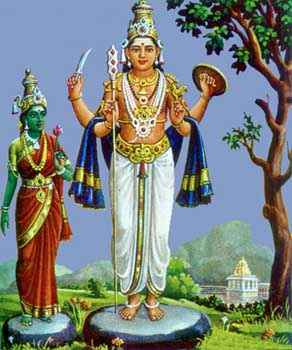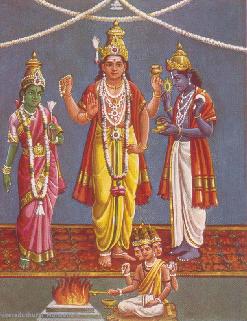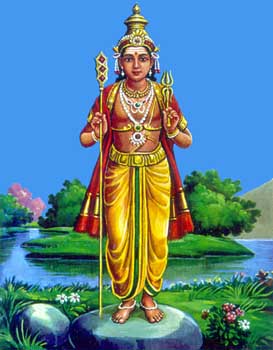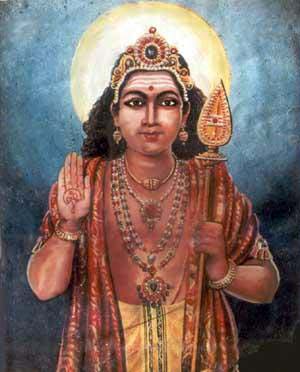
|
|||||||
|
| |||||||
The Development of Muruku-Muruka-Vēlan and Ce-ce-cey-Ceyon in Cankam Literature
K.V. Ramakrishna RaoKaumara worship in India can be traced back to vedic times based on Sanskrit literature and 3rd century BCE based on Cankam literature. Scholars differ in the origin of the deity; some trace it to the Indo-Iranian region (northwestern part of India) and others to a Mediterranean origin. Tamil scholars fervently argue that it belongs to ancient Tamilakam, tracing it to the worship of Murukan. Though Kumāra-Kārttikeya-Subrahmaņya worship was in popular in the North in ancient times, it is still popular in the South. It is believed that Muruku-Muruka-Vēlan and Ce-Ce Ey-Ceyon-Cevv&ēl worship evolved separately. Indeed, in Tamilnadu it has become of part and parcel of socio-religious activities on various occasions. This study examines the possible development of Muruku-Muruka-Vēlan or Ce-Ce Ey-Ceyon myth in Cankam literature and its culmirration into the full-fledged worship as seen today. The Nikaņṭu compilers have meticulously recorded different names attributed to Kārttikeya-Murukan, thereby exhibiting his characteristics. In Cankam literature, it has been closely associated with the fire cult of the ancient Tamils, transformed into naturalistic, theriomorphic, anthropomorphic, fetishistic and symbolic modes of rites, rituals and worship. Fire CultFire has been an important factor occupying almost all aspects of life, perhaps from birth to death of man and even beyond. The various terms used for fire in Cankam literature prove its full association and utilisation for sacred and secular purposes. Tolkappiyam refers to fire worship. The specific expressions used are Koṭinilai, Kantali and Valli (Porul. Purattinai.86) to denote the existence of worship in three forms: the cūr in the sky, fire on the earth and moon on the waters. Not only the word tēvam but also the specific expressions teral arun kaṭavuḷ (Akam. 396:1) = fiery-unique God, arum teral marapir kaṭavuḷ (Akam. 372:1) = unique-fiery-traditional God, teral aur marapin kaṭavuḷ (Akam. 13:3) = fiery-unique-traditional God, Teral arum kaṭavuḷ (Nat.189:3) = fiery-unique God etc., prove the fact. In all these references, the God is invoked and worshipped; and even an oath/vow is taken before Him (as a witness). Circumambulating a fire by a couple is also part of marriage ritual (Kali. 69:5). Fire forms part of veriyāḷal (bacchanalian dance) as detailed in many places where the vēlan takes active part and the Muruku/Murukan-affected young girl/lover is treated (Akam. 22,98,138,382; Muruku. 234; Nat. 47). Funeral practices are also mentioned (Puram. 239:20-21; 231:1-3; 238:1-5; 246:11-12; 356, 363). Fire is compared with pregnancy (Nat. 380:1-5), newly born children (Puram. 279:6-7), Sati (Tol. Porul. Purat. 79; Puram. 62:13-16, 240, 246, 247, 256, 280; Kurun, 69), Arundhati (Padit. 89:18-20), women, rams (Akam. 274:4-5), mountains, trees, flowers, cūr, anaŋku, kollippavai, Ce, Ce Ey or Ceyon, veriyāṭal and vēlvi (yajña). Here, the references connected with the development of Murukan/Kārttikeya myth alone are considered. MountainsThe relation of fire with mountains may have been due to the existence of volcanos in the past. D.N. Wadia has noted that towards the close of the Cretaceous era, a large part of the Indian peninsula was affected by a stupendous outburst of volcanic energy, resulting in the buildup of thick layers of lava and associated pyroclastic materials.4 Turning to Tamil literature, the fire produced in the mountains appears in the desert (Ingu. 338:3). The mountain is so covered with the flowers of silkcotton trees (Ilavam) that it appears as if it is surrounded with fire-creepers (Ing. 358:1). The fire that originated through bamboo trees (by friction) spreads to entire hillsides by the strong winds and the lengthy creeper-like flames enter the gaps of caves and stones of hills, thereby resulting in small explosions due to expansion (Ing. 395:1-2). The darkness of the caves of the mountain is removed by the glowing lance (Akam. 272:4-6). Lamps are lit on the top of the hills (Akam.185:10-11; 265:2-3). Thus, kunram, varai, malai etc. have always been associated with fire. Coming to Murukan, the famous Arupaṭai Vīṭkaḷ or six battle camps are situated only on the hills: Tirupparankundram, Tirucīr Alaivai (Tiruchendur), Tiru Avinaŋkuṭi (Palani), Tiruverakam (Swami Malai), Kunrutōratal (other hills and hillocks) and Palmutircolai (Alakar Malai). The association of Kārttikeya with caves and mountains may be noted: bāla-griha = seizure of children as Skanda (according to Mahabharata). Later Guha (Tamil: Kukan) was added to the lists of rudras as per the text of Revali Kalpa.5 TreesFire and trees are closely associated in Tamil literature. There are many references about the burning down of trees, towns and granaries in army action (Puram. 6:22, 7:7-8, 16:17, 344:5, etc.) The practice of sowing millet after burning down trees is also mentioned (Akam. 288:4-5, 368:1-2). Forest fires are also described (Akam. 103, Ing. 376:2, Padit, 25:6-7, 40:28-30). During such processes and operations, some trees might have escaped from the ravages of fire standing against it. Such trees might have been considered sacred and divine, as even fire could not have done anything. Then people might have started revering the deities residing in those trees. Imayavaramban Netunceralatan attacked his enemies in an island surrounded by roaring ocean and cut down their divine kaṭampu tree. This exploit was repeatedly compared with the defeat of Cūr by Vēl (Padit. 88:5-7; 11:12-13; 20:3-4; a murasu was made out of it 17:4-6). Vanni (cuma tree), kaṭampu, banyan and other trees are considered divine. Murukan is also called as Kaṭampan and Vannippukkaran. FlowersThe intimate relationship between fire and lotus was elaborately brought out by ancient Tamil poets (Akam. 106:1, 191:2; Perum. 159; Perum. 289-90, etc.). The reddish colour, the petals, their arrangement, resemblance with flames, origin from waters and other details are emphasized. The kuvalai (oleander), alari (Indian willow), venkai (Pterocarpus bilobus) and kantal (Gloriosa superba) are frequently compared with the characteristics of fire. CūrCūr is the goddess variously mentioned as born of rains, residing on the hills or hill sides, in the springs, forests, trees, etc. She was born of rains (Akam.303:5-6). This can be compared with the Tevayānai myth. She has terrible and fearful forms; capable of taking any form; affecting women and children (compare with Jara, Jataharini and Ahoyi of Sanskrit literature); and is just like fire. She likes kantal flowers and therefore, even if bees approach them, they would be made powerless by her (Padit. 67:19-20). A lady-love shivers with fear about Cūr, as she
might affect her chastity (Kurun. 52:1-2). Tasty rice with curry
is offered to Cūr after a sacrifice (Natri.
367:1-4). A hero takes a vow invoking cūrara makaḷ in grasping the arms of his
lady-love (Kuru. 53:1, 6-7). This is similar to taking vows
before Teral arum kaṭavuḷ and fire. Thus, the myth of fire and
cūr overlaps, leading to the creation of Muruka with the
importation of another cūr as shown below.
There is, of course, another cūr mentioned denoting Cūrapatuman, defeated by Murukan. Cūr was killed by Cey (Puram. 23:4). Cūr was killed by Cey (Puram.23:4). Cevvēl cuts down the mango tree of Cūr to the roots. Though the commentators imply the killer to be Murukan, the expressions used are Cey or Cevvēl (reddish Vēl), fiery Vēl, neṭuvēl (long lance), one has the v&ēl, and so on. Narrinai perhaps gives a clue to differentiate between the two cūrs as noted above: the goddess (anaŋku) who produces the waterfalls resides in the hills; terrifying and fearful caves are there in such hills; like a lightning, the glowing lance shows the way in such caves driving darkness away with its light. This shows the gradual development of the Murukan myth by transforming Cey, the Red One, into Murukan and Cūr into Cūrapatuman. The subjugation of Cūr is further shown as follows: the spring with divinity falls from the hills; the cūr women dance according to the tune of natural music produced by the waterfalls and adorn themselves with the garlands of kuvalai and kantal (Nat. 34:1-6). AnaŋkuThere is another goddess Anaŋku mentioned repeatedly with the same characteristics as that of Cūr. She resembles fire more than Cūr (the characteristics are affecting and inflicting, like God in the sky, resides in the hills, on the top of the hills, like a disease, of waters, with bewitching beauty, fear, of great strength, of trees. Besides her natural dwelling places, she has temples (Puram. 247:4) and idol-forms (Akam. 159:5-6). This proves that she attained the status of goddess with full-fledged worship. She is compared with fire: 'Just like the fire produced by drilling in the wood is used to burn the other wood, the lady has become an anaŋku for her own town' (as it would be burned down by the king, whom she has refused to marry. Puram. 349:6-7).
Fire and Ce, Ey or CeyonCe denotes red colour. Cey or Ce Ey connotes the Red One, juvenility, son, child, Mars and bamboo. Ce (Puram. 171:8,9), Ce Ey (Kali. 103:50-52) or Ce Ey (Kali. 104:25) mean also bull. Accordingly, Ceyon means one with reddish colour with youth or with bull, thus implying Śiva and then Murukan, however both names are not found as such. In fact, it may be mentioned that V.S. Agrawala notes three stages in the development of myth in Sanskrit literature:6
As a result of the last assimilation, he was made the husband (commander) of Devasenā i.e, the daughter (divine army) of Indra. Taking clue from Tōlkappiyam, some commentators while interpreting Mayon, the Black One as Tirumaḷ (Vişņu), started alluding that Ceyon, the Red One, was Murukan. Initially, Cey or Ceyon must have been a fire-god and then was transformed into Murukan. This transformation can be found in Tirumurukārruppaṭai itself, besides Paripātal, which belongs to later Cankam period. The former starts with a specific reference to sun worship (Muruku.1-2) and goes on to praise Ceyon: the long fiery Vēl (lance) that killed Cūr (46); Ce Ey with reddish lance Cevvēl (61); from the first face, many rays spread like fire or sun (92); His body is red, he wears red dress with reddish flowers in the ears (206-7); He has ram and peacock as vahanas (210); he is nursed by six women, implying six Krittikā women (255); He is the Son of God who resides under a mystic banyan tree (256); Son of the Goddess of the mountain (257); Son of Korravai (258); Child of Palaiyol, the ancient goddess (259); killer of the mountain Krauñca (266); the Red One Ce Ey (271) and killer of Cūr (275). In Paripātal, references to Murukan are direct: he is born of fire (5:30-35); Analan (Agni) gives him an elephant (5:57-58), whereas Ganaman (Yama) gives him a ram (61-62). Later, other known details are given faithfully. From the above it can be noticed that, in his metamorphosis from fire-god to Murukan, Ceyon is made to have these characteristics by having reddish dress (another name for Agni in Tamil), riding a ram, and so on. In the case of anaŋku, it is directly said that 'Murukan is anaŋku' and, thus, straightaway taking over anaŋku by Ceyon or Murukan (Akam. 98:10: murukan anaŋku ena), whereas Cūr has been subjugated as explained above. Krittikā starsThough the name kārttikai as such is not found in the literature, it is implied through the specific terms arumīn (six stars), eri (fire), alaḷ (flame), araḷ (fire) and aḷ (fire). Moreover, Arundhati is excluded from the 'seven women', as when the wife of Agni, Swāhā, tried to assume the form of the wives of the Saptarişis, she could not succeed in the case of Salini i.e, Arundhati (Pari. 5:44). In Paṭirruppattu (Paṭit. 65:9), she is specifically mentioned as kamara kaṭavuḷ i.e, the Goddess who frightens kāmam (lust). Salini has another meaning also, i.e. she is considered as a chaste woman accompanying women who are pregnant for the first time, going to the temples (Madurai. 603-610). In contrast, Kārttikeya-Murukan is known as kumarak kaṭavuḷ, the handsome young god. Veriyāṭal in KalamThe worship of Cey, Ce Ey or Ceyon and Muruku or Neṭuvēl is always associated and accompanied with the following:
Actually, in the references about veriyāṭal, the girl ridicules the performance of Veriyāṭal and the hypocricy of the vēlan, as she knows her position very well. In fact, the lover is visiting her stealthily as usual, at that time, when veriyāṭal takes place. Therefore, it is understood that the women, who are supposed to have been affected or infected by cūr, anaŋku, Muruku or Neṭuvēl are pregnant in many cases. Neṭuvēl and NeṭiyonMurukan is compared with a minor king neṭuvēl (Akam. 1:3). Another king Neṭiyon is also frequently mentioned (Puram). Though later Neṭiyon was used to imply Tirumaḷ or Vişņu, here it is used to imply only Murukan.7 Neṭuvēl deserves to be worshipped (Akam. 22:6). He stands tall on his hill (Pari. 19:84). Neṭuvēl has the cock flag (Muruku. 210). Neṭuvēl is the king of the Kaṭampar, a tribe (Perumpan. 75). A friend of his lady-love asks whether the disease would give any bad name to Neṭuvēl (Natri. 173:9). Thus, Neṭuvēl appeared to have all the characterstics of Muruku. Therefore, it is possible that Neṭuvēl or Neṭiyōn might have been so popular among the poets that, at one stage, he was compared with Muruku or converted into Murukun with all his characteristics. The name Muruku as such implies Murukan (Natri. 34:11 muruku means beauty), the mother of a lady-love worships Muruku (Natri. 47:10 Muruku is worshipped by women) and the strength of an elephant is compared with Muruku (Natri. 225:1 Elephant is his vahana in Paripātal). Thus, the Muruku-Neṭuv&ēl-Neṭiyon characterstics are merged together in Murukun. WomenWomen worship Murukan-Kārttikeya to obtain beautiful husbands, beget children, long life of husband, welfare of the family and so on. However it may be mentioned that in Mahārās×tra, women are afraid to visit Kumāra temples as they might get affected by Him. Interestingly, in Purananuru (279:6-7), there is a reference about the practice of not touching of vessels of Murukan temples by virgin/pregnant women. Scholars have not given any explanation for this strange reference. But by comparison with the Skanda myth of Sanskrit literature, it can be explained that women might not visit the Murukan-Kārttikeya temples in view of the traditional belief that he might make them pregnant, if they are virgins or their foetus would be taken away by Him, if they are pregnant. In Bengal, public women used to worship Kārttikeya and they would sleep in His temple once in a year as a mark of propitiation. Thus, the veriyātal can also be considered as a puberty rite, where initiation into adult status is declared to others with tribal lore, dance and ceremonies. Or the pregnant women are protected against the force affecting the pregnancy through such ritual. InferenceTraditionally, the direction and angle of fire (Agni) is the southeast. Therefore, the presence of fire-cult in that area of India is not exaggerated. Geologically, the southern part of India is older than the North. The fire cult must have been the oldest of any civilization and thus, from it the evolution of the myth of Murukan-Kārttikeya is understandable as explained above. Now, the different modes of worship are considered:
ConclusionIn view of the above discussion and inference, the following conciusions may be drawn:
Notes and References
This paper was presented at the First International Conference Seminar on Skanda-Murukan, December 1998 |



